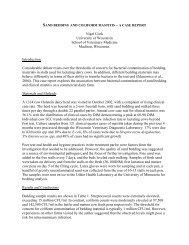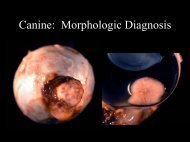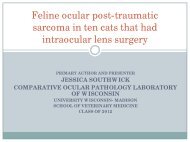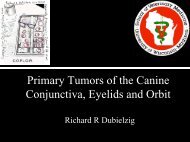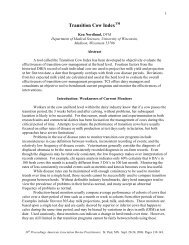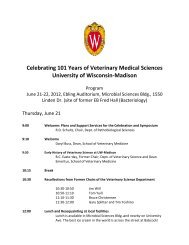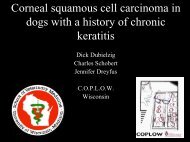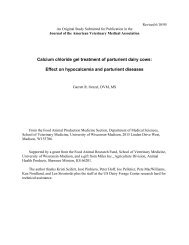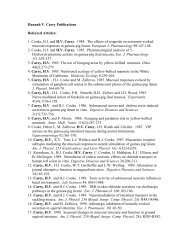Preconvention Sem<strong>in</strong>ar 7A: <strong>Dairy</strong> Herd Problem Investigation Strategies:Lameness, Cow Comfort, and <strong>Rum<strong>in</strong>al</strong> <strong>Acidosis</strong>production is not triggered by decl<strong>in</strong><strong>in</strong>g rum<strong>in</strong>al pH, but rather is determ<strong>in</strong>ed almost entirely by theamount <strong>of</strong> physical fiber present <strong>in</strong> the diet. Saliva is secreted dur<strong>in</strong>g chew<strong>in</strong>g activity (eat<strong>in</strong>g andrum<strong>in</strong>ation) <strong>in</strong> response to the amount <strong>of</strong> physical fiber present <strong>in</strong> the diet.Acid absorption. The ability <strong>of</strong> the rumen to rapidly absorb organic acids from the rumencontributes greatly to the stability <strong>of</strong> rum<strong>in</strong>al pH. It is rarely difficult for peripheral tissues toutilize VFA already absorbed from the rumen; however, absorption <strong>of</strong> these VFA from therumen can be an important bottleneck.Absorption <strong>of</strong> VFA from the rumen occurs passively across the rum<strong>in</strong>al wall. This passiveabsorption is enhanced by f<strong>in</strong>ger-like papillae that project away from the rumen wall. Thesepapillae provide a huge surface area for VFA absorption. <strong>Rum<strong>in</strong>al</strong> papillae <strong>in</strong>crease <strong>in</strong> lengthwhen cattle fed higher gra<strong>in</strong> diets; this presumably <strong>in</strong>creases the surface area and absorptivecapacity, which protects the animal from acid accumulation <strong>in</strong> the rumen. If the absorptivecapacity <strong>of</strong> these cells is impaired (e.g., chronic rumenitis with fibrosis), then it becomes muchmore difficult for the animal to ma<strong>in</strong>ta<strong>in</strong> a stable rum<strong>in</strong>al pH follow<strong>in</strong>g a meal.Net rum<strong>in</strong>al pH regulation. Mean rum<strong>in</strong>al pH values are not dramatically affected by largedietary changes, but the lowest (nadir) pH values are greatly affected by diet (Table 3). Thisresponse is <strong>in</strong> keep<strong>in</strong>g with the nature <strong>of</strong> regulation <strong>of</strong> rum<strong>in</strong>al pH that has been described above.Cattle are generally able to ma<strong>in</strong>ta<strong>in</strong> rum<strong>in</strong>al pH with<strong>in</strong> physiological limits by their ownregulation <strong>of</strong> <strong>in</strong>take, endogenous buffer production, microbial adaptation, and VFA absorption.However, if the amount <strong>of</strong> fermentable carbohydrate consumed results <strong>in</strong> more acid productionthan the system can accommodate, rum<strong>in</strong>al pH compensation fails and rum<strong>in</strong>al pH dropsdrastically.Table 3. Effect <strong>of</strong> concentrate level <strong>of</strong> feed<strong>in</strong>g on <strong>in</strong>take, milk yield, and production <strong>in</strong>Holste<strong>in</strong> cows (17 daily cannula collections)OutcomeMedium Concentrate (50%) High Concentrate (25%)ADF, % <strong>of</strong> DM 17.4 12.1NDF, % <strong>of</strong> DM 35.4 31.0DM <strong>in</strong>take, lbs/day 44.7 44.2<strong>Rum<strong>in</strong>al</strong> pH, mean 6.28 6.13<strong>Rum<strong>in</strong>al</strong> pH, nadir ~6.1 ~5.6Data adapted from Kennelly et al., 1999.As rum<strong>in</strong>al pH drops below the physiological threshold <strong>of</strong> about 5.5, cattle develop subacuterum<strong>in</strong>al acidosis (SARA). Fortunately, rum<strong>in</strong>al VFA have a pKa <strong>of</strong> about 4.9, which means thatthey are rapidly shift<strong>in</strong>g toward the undissociated (protonated) form at this pH. This removes afree hydrogen ion from the rum<strong>in</strong>al fluid and greatly facilitates their absorption across therum<strong>in</strong>al epithelium, s<strong>in</strong>ce only undissociated acids can be passively absorbed.Lactate production. Unfortunately, ga<strong>in</strong>s <strong>in</strong> VFA absorption at rum<strong>in</strong>al pH below 5.5 can be<strong>of</strong>fset by lactate production. As pH drops, Strep. bovis beg<strong>in</strong>s to ferment glucose to lactate<strong>in</strong>stead <strong>of</strong> VFA. This is a dangerous situation, s<strong>in</strong>ce lactate has a much lower pKa than VFA(3.9 vs. 4.8 - see Figure 5).<strong>University</strong> <strong>of</strong> Wiscons<strong>in</strong>, School <strong>of</strong> Veter<strong>in</strong>ary Medic<strong>in</strong>e, 2015 L<strong>in</strong>den Drive, Madison, WI 5370694
Preconvention Sem<strong>in</strong>ar 7A: <strong>Dairy</strong> Herd Problem Investigation Strategies:Lameness, Cow Comfort, and <strong>Rum<strong>in</strong>al</strong> <strong>Acidosis</strong>g100%Dissociated VFA, %75%50%MORE [HA]:- Undissociated(Associated)- Protonated- Uncharged- Non-Ionized- Bound- Conjugate Acid(H + donor)"Acetic Acid" formRapidly Absorbed(diffuses acrossrum<strong>in</strong>al epithelium)LactatepKa = 3.9VFApKa = 4.8MORE [A - ] + [H + ]:- Dissociated- Unprotonated- Charged- Ionized (Anionic)- Free- Conjugate Base(H + acceptor)"Acetate" formSlowly Absorbed(wait<strong>in</strong>g to be protonated,some active absorption?)25%0%1.0 2.0 3.0 4.0 5.0 6.0 7.0 8.0Figure 5. Titration curves for VFA and lactate.<strong>Rum<strong>in</strong>al</strong> pHAt a rum<strong>in</strong>al pH <strong>of</strong> 5.0 lactate is 5.2 times less dissociated than VFA. As a result, the lactatestays <strong>in</strong> the rumen and contributes to the downward spiral <strong>in</strong> rum<strong>in</strong>al pH. Fiber-digest<strong>in</strong>gbacteria are severely <strong>in</strong>hibited as pH decl<strong>in</strong>es. Pure lactate producers such as Lactobacillus maybeg<strong>in</strong> to proliferate at these lower pHs.Additional adaptive responses are <strong>in</strong>voked when rum<strong>in</strong>al pH drops below 5.5 and lactateproduction beg<strong>in</strong>s. Lactate-utiliz<strong>in</strong>g bacteria, such as Megasphaera elsdenii and Selenomonasrum<strong>in</strong>antium beg<strong>in</strong> to proliferate. These beneficial bacteria convert lactate to other VFA, whichare then easily protonated and absorbed. However, the turnover time <strong>of</strong> lactate utilizers is muchslower than for Strep. bovis. Thus, this mechanism may not be <strong>in</strong>voked quickly enough to fullystabilize rum<strong>in</strong>al pH. Periods <strong>of</strong> very high rum<strong>in</strong>al pH, as dur<strong>in</strong>g feed deprivation, may <strong>in</strong>hibitpopulations <strong>of</strong> lactate utilizers (which are sensitive to higher rum<strong>in</strong>al pH) and leave them moresusceptible to severe rum<strong>in</strong>al acidosis. Other aspects <strong>of</strong> this delicate rum<strong>in</strong>al microbial balancemay be disrupted when rum<strong>in</strong>ants are deprived <strong>of</strong> feed for a time.Besides disrupt<strong>in</strong>g microbial balance, feed deprivation causes cattle to overeat when feed isre-<strong>in</strong>troduced. This creates a double effect <strong>in</strong> lower<strong>in</strong>g rum<strong>in</strong>al pH. As a result, cycles <strong>of</strong> feeddeprivation and re-feed<strong>in</strong>g are more important risk factors for SARA than is diet formulationitself. An example <strong>of</strong> rum<strong>in</strong>al pH follow<strong>in</strong>g a period <strong>of</strong> feed deprivation and re-feed<strong>in</strong>g ispresented <strong>in</strong> Figure 6.<strong>University</strong> <strong>of</strong> Wiscons<strong>in</strong>, School <strong>of</strong> Veter<strong>in</strong>ary Medic<strong>in</strong>e, 2015 L<strong>in</strong>den Drive, Madison, WI 5370695



